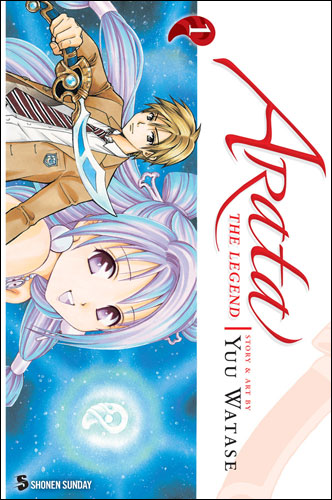
Review: Arata: The Legend, Vols. 1-2
Here in the United States, Yuu Watase’s name is practically synonymous with magical-girl manga, thanks to the enduring popularity of Alice 19th, Ceres: Celestial Legend, Fushigi Yugi, and Fushigi Yugi: Genbu Kaiden. Watase has written other kinds of stories — Imadoki! focuses on a high school gardening club, for example — but her primary audience has always been teen girls. Her latest effort, Arata: The Legend, is her first work to be serialized in a shonen (or boys’) magazine. I’m happy to report that Arata will appeal to the female readers who helped popularize Fushigi Yugi and its prequel, as well as fans of shonen hits such as Rumiko Takahashi’s InuYasha and Hiromu Arakawa’s Full Metal Alchemist.
Arata: The Legend, Vols. 1-2
By Yuu Watase
Rating: Teen (13+); non-sexual nudity, fantasy violence
2010, VIZ Media
ISBN, Vol. 1: 978-1421534206
ISBN, Vol. 2: 978-1421534213
 Like the heroines of Fushigi Yugi and Alice 19th, the titular character in Arata: The Legend is transported from present-day Japan to a magical realm, where he’s mistaken for another young man named Arata. The twist: Arata Hinohara’s double stands accused of murdering the country’s ruler, Princess Kikuri! Unable to escape from Kikuri’s “protectors” — the very people responsible for her assassination — Hinohara is condemned to the island of Gatoya, a prison colony ruled by a sadistic warden. Meanwhile, Arata’s doppleganger finds himself in the opposite predicament, wandering the streets of modern Tokyo agog at the technology and bewildered by the Hinohara family’s firm insistence that he’s their son.
Like the heroines of Fushigi Yugi and Alice 19th, the titular character in Arata: The Legend is transported from present-day Japan to a magical realm, where he’s mistaken for another young man named Arata. The twist: Arata Hinohara’s double stands accused of murdering the country’s ruler, Princess Kikuri! Unable to escape from Kikuri’s “protectors” — the very people responsible for her assassination — Hinohara is condemned to the island of Gatoya, a prison colony ruled by a sadistic warden. Meanwhile, Arata’s doppleganger finds himself in the opposite predicament, wandering the streets of modern Tokyo agog at the technology and bewildered by the Hinohara family’s firm insistence that he’s their son.
ADVERTISEMENT
ADVERTISEMENT
Watase’s consummate skill as a storyteller is evident from the very first chapter of Arata. In just thirty pages, she establishes the main premise of the series, introduces us to our principal hero and villain, and throws readers a major curveball. Like Rumiko Takahashi, Watase has great comedic chops; her characters find themselves in stock situations (e.g. Arata accidentally splashes down in a hot spring filled with beautiful young bathers, with predictable results), yet these scenes are surprisingly funny, thanks to Watase’s first-rate timing. Her artwork, too, is a big plus. She draws costumes and settings with the kind of loving detail that makes her fantasy realm seem like a real place, while her fight scenes are a model of clarity, efficiency, and grace.
Watase’s many years of writing for female audiences is evident throughout the series. In volume one, for example, Watase dedicates several chapters to Hinohara’s life in the present day, documenting the emotional impact of the bullying he endures at school. These early scenes are crucial to establishing Hinohara’s character; though he eventually discovers that he can conjure a sword from his body, Hinohara’s utter lack of confidence compromises his ability to use the Hayagami. Such character development is de rigeur in shojo manga, but less common in shonen; more often than not, manga artists are content to depict their heroes as stoic outsiders or tough-guy misfits, seldom revealing their true vulnerability.
The only disappointing aspect of Arata is the lack of memorable female characters. Princess Kikuri appears in a handful of scenes, registering more as sacrificial lamb than true character. The only other significant female cast member is the sweet but dim Kotoha, who doesn’t seem to realize that Hinohara is not the same Arata whom she adored as a child. Kotoha’s primary function seems to be damsel in distress, as she necessitates a rescue at least once or twice per volume, often from predatory male characters.
That said, Arata: The Legend seems poised to become a crowd-pleaser with the under-sixteen set, thanks to its attractive artwork, fast-paced story, and sympathetic hero. Librarians and parents wishing to pre-screen the title before purchasing it can read entire chapters online at VIZ’s Shonen Sunday website.
Review copies provided by VIZ Media, LLC. This is an expanded version of a review that ran at The Manga Critic on 8/9/09.
Filed under: Manga, Reviews, Uncategorized
About Katherine Dacey
Katherine Dacey has been reviewing comics since 2006. From 2007 to 2008, she was the Senior Manga Editor at PopCultureShock, a site covering all aspects of the entertainment industry from comics to video games. In 2009, she launched The Manga Critic, where she focuses primarily on Japanese comics and novels in translation. Katherine lives and works in the Greater Boston area, and is a musicologist by training.
ADVERTISEMENT
ADVERTISEMENT
SLJ Blog Network
One Star Review, Guess Who? (#202)
Review of the Day: My Antarctica by G. Neri, ill. Corban Wilkin
Parsing Religion in Public Schools
Take Five: LGBTQIA+ Middle Grade Novels
ADVERTISEMENT







